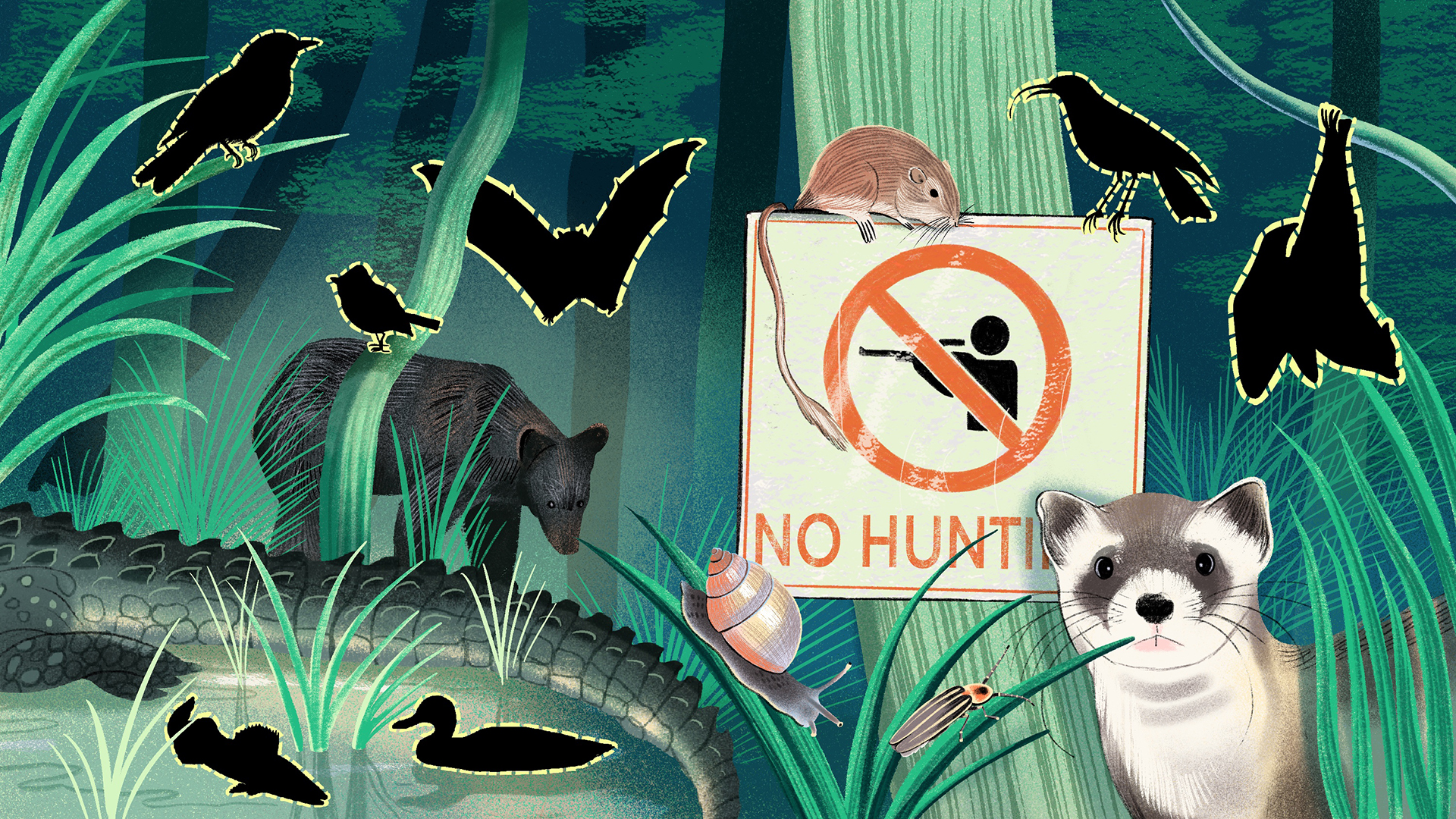
Give Endangered Species Act people some money!
Full article from Benji Jones in Vox under Down-To-Earth Article
Exactly five decades ago, Congress did what would be unimaginable today: It passed a powerful environmental law with almost unanimous support. In 1973, the House voted in favor of the Endangered Species Act, 390 to 12.
“Nothing is more priceless and more worthy of preservation than the rich array of animal life with which our country has been blessed,” Republican President Richard Nixon said upon signing the act into law.
Endangered Species Act, briefly explained
At the core of the ESA is a list. On it are plants and animals that the US Fish and Wildlife Service (FWS) and the National Marine Fisheries Service (NMFS) — agencies that oversee the act on land and at sea, respectively — determine are at risk of extinction, or will be soon. Species in the former category are classified as “endangered,” and those in the latter are classified as “threatened.” Typically, the government makes those determinations after environmental groups present it with overwhelming evidence, in the form of a petition, that a certain species is in peril.
As of late 2023, there are roughly 1,670 species on this list, according to a Vox analysis of data from the FWS and NMFS. Three-quarters of them are classified as endangered, while the rest are threatened. A little more than half of these threatened and endangered species are plants.
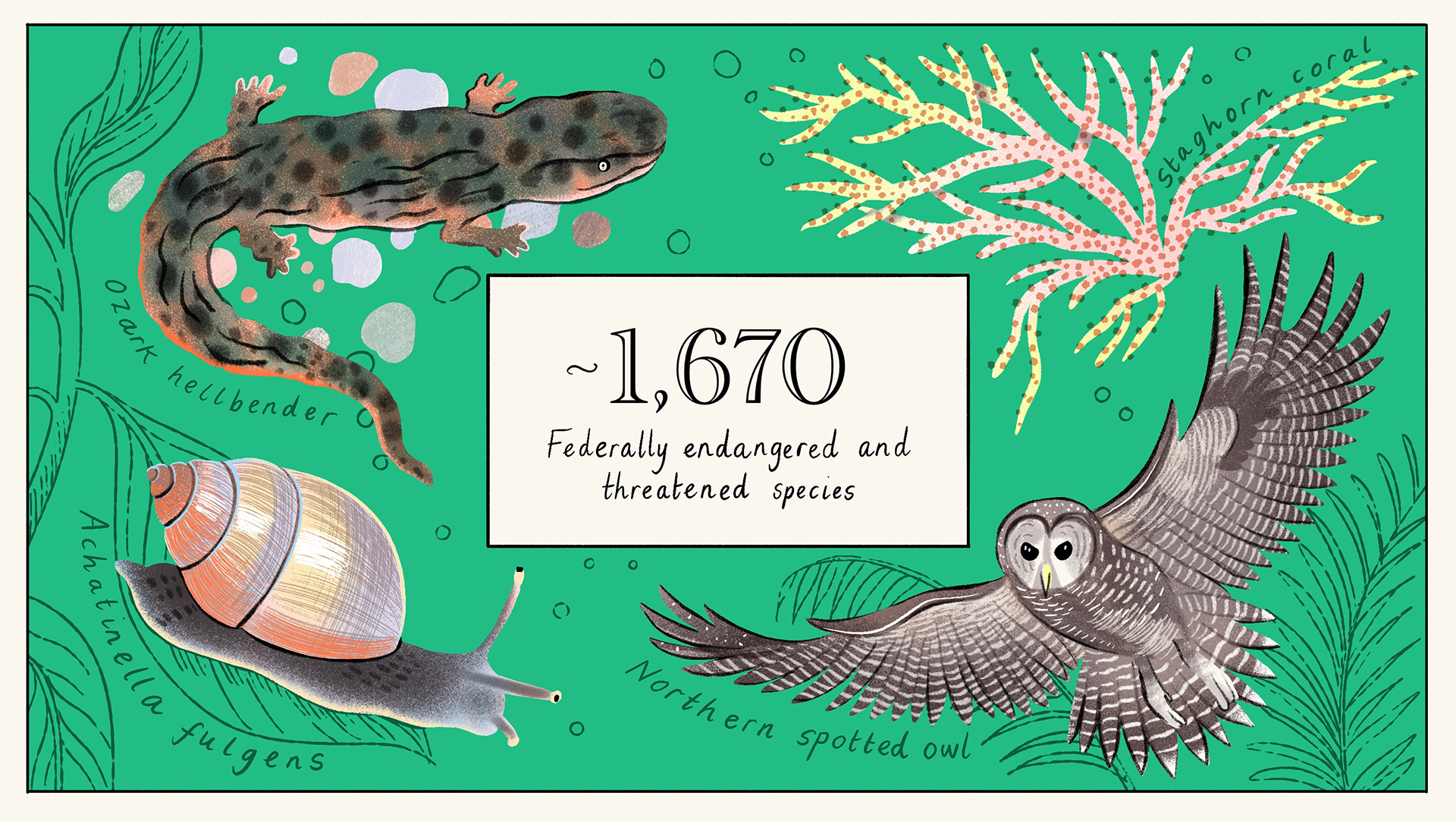
The Endangered Species Act makes it illegal to kill, harm, or capture endangered animals. The law refers to these actions collectively as “take.” You can’t, say, bring an endangered Florida panther home as a pet, or hunt one down. Plants and species classified as threatened are treated somewhat differently under the law, but in many cases the same rule applies, according to Daniel Rohlf, a law professor at Lewis and Clark Law School. On nonfederal lands, for example, it’s not illegal to harm endangered plants as long as it’s not in violation of any state laws.
The act does a number of other things for endangered species, such as requiring that the government craft a plan to restore these species’ populations. If you want to learn more, the Congressional Research Service has a great primer.
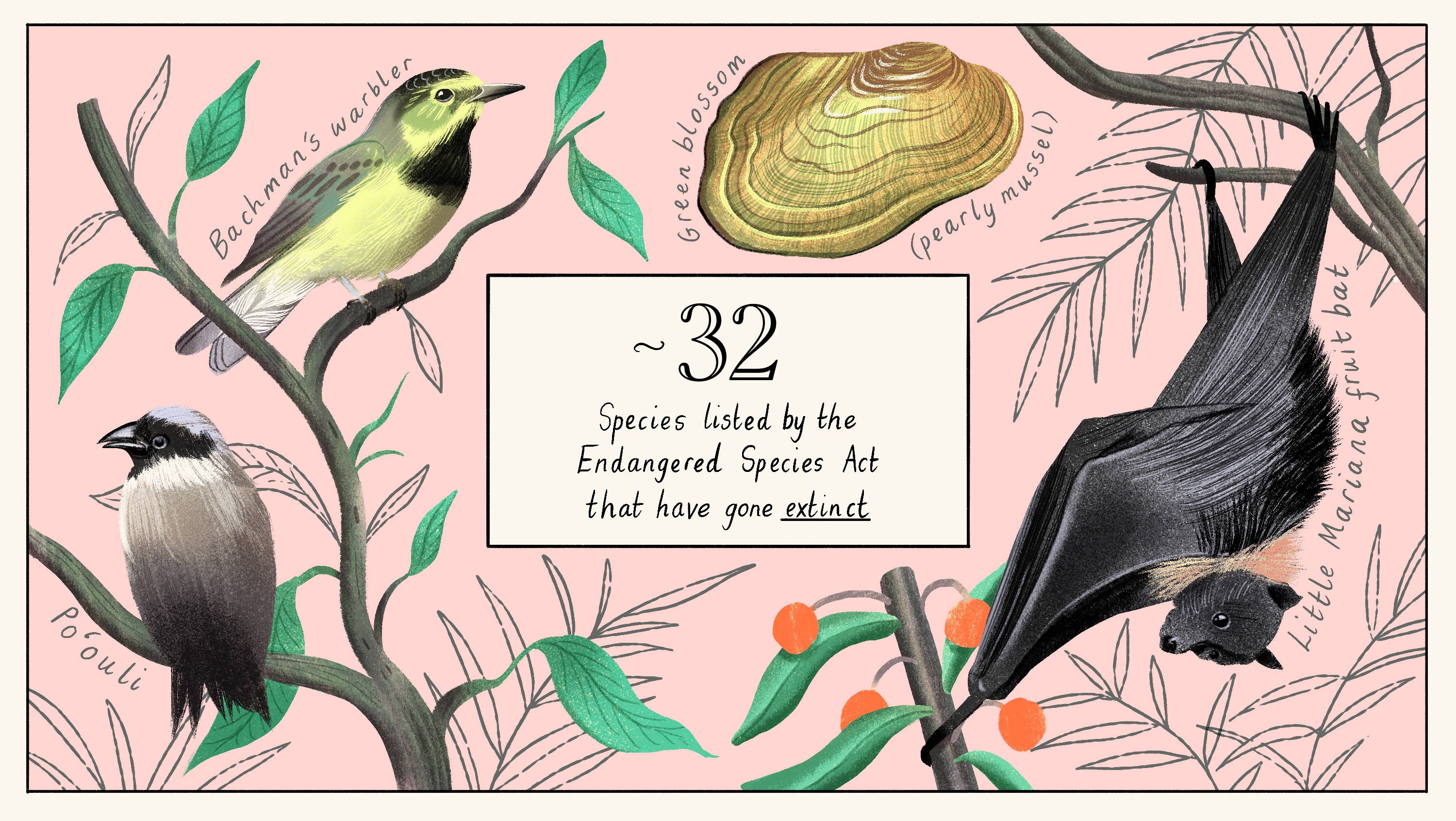
Since 1973, only around 32 listed species — less than 2 percent — have gone extinct. The list of the lost includes birds like the Bachman’s warbler, mammals like the little Mariana fruit bat, and several species of freshwater mussels.
Black-footed ferrets are among the species arguably saved from extinction by the ESA. In 1980, these cute, carnivorous mammals had vanished from the Great Plains and were presumed extinct. But one morning the following year, a ranch dog in the small town of Meeteetse, Wyoming, brought its owners a dead animal that looked like a mink, with some noticeable exceptions: It had black feet and a black mask. The owners brought the carcass to a local taxidermist, who recognized it as an endangered species.
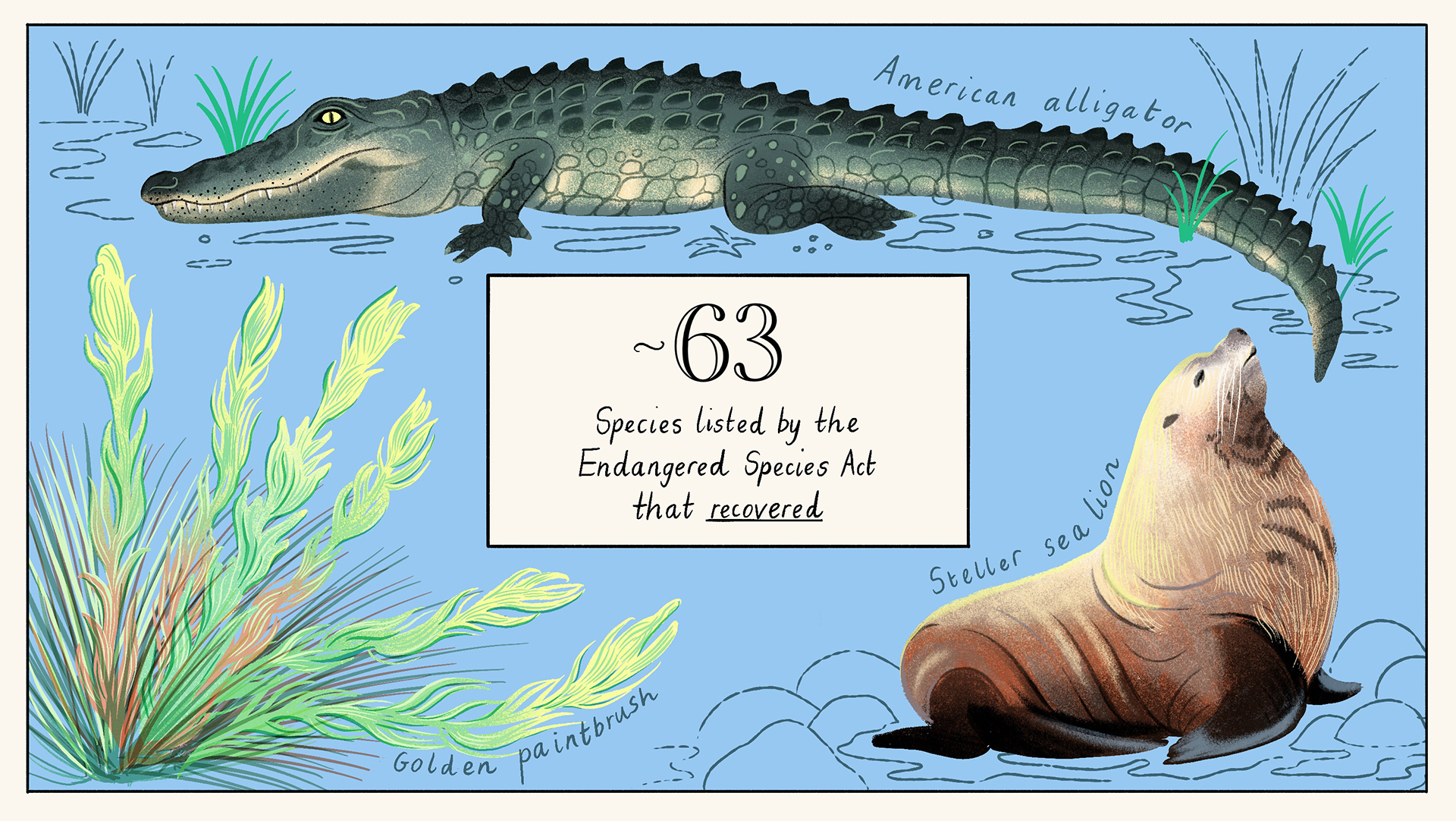
The dog’s discovery helped lead researchers to an unknown population of black-footed ferrets. And animals from that population formed the basis of a successful captive breeding effort — which was bankrolled, in part, by the ESA. The breeding program has since introduced thousands of ferrets back to the wild across eight states, Canada, and Mexico.
In the last five decades, the government has removed more than 60 species from the endangered species list because, according to its assessment, they’ve recovered. (What it means for a species to have “recovered” is hotly debated and doesn’t always mean that the species is found throughout its historic range.) Among them: the American alligator, the peregrine falcon, three subspecies of Channel Island foxes, and a plant called the golden paintbrush. Each has its own success story.
Critics of the ESA, including Republican lawmakers, see that number of “delisted” species — which is obviously not enormous — as an indication that the law doesn’t work. If the ESA were successful, they say, the government would have delisted more species by now. They’ve used what some lawmakers have called a “disappointing track record” to justify reforms that seek to weaken the act’s regulatory power.
Environmental advocates like Greenwald see it differently. Recovery is a tall order, they say, especially for species that were on the brink of extinction when they were first listed, which is often the case. The number of species taken off the list is “a poor measure of the success of the ESA,” Greenwald and his colleagues at the Center for Biological Diversity wrote in a 2019 study. “Most species have not been protected for sufficient time such that they would be expected to have recovered.”
The law could do so much more
But even staunch defenders of the ESA say it could be doing much more. For one, the act protects only a fraction of the species that are slipping away. In the US, more than 5,300 plant and animal species are at a “high risk” of extinction, according to NatureServe, a nonprofit data organization. These include species like the Bethany Beach firefly, a lightning bug native to coastal Delaware that scientists say is imperiled yet remains unprotected under the ESA. (Again, the act protects only about 1,670 species.)
“There are hundreds and hundreds of species that need consideration for protection that the Fish and Wildlife Service isn’t doing anything about,” Greenwald said.
Part of the problem, environmental groups say, is that the FWS is failing to work through a backlog of species that are in desperate need of protection. “Under the ESA, decisions about protection for species are supposed to take two years, but on average, it has taken the Fish and Wildlife Service 12 years,” wrote researchers, including Greenwald, in a 2016 study. “Such lengthy wait times are certain to result in loss of further species.” (A more recent assessment indicates that wait times between 2010 and 2020 were shorter, likely because the FWS received fewer petitions to list species during that time.)
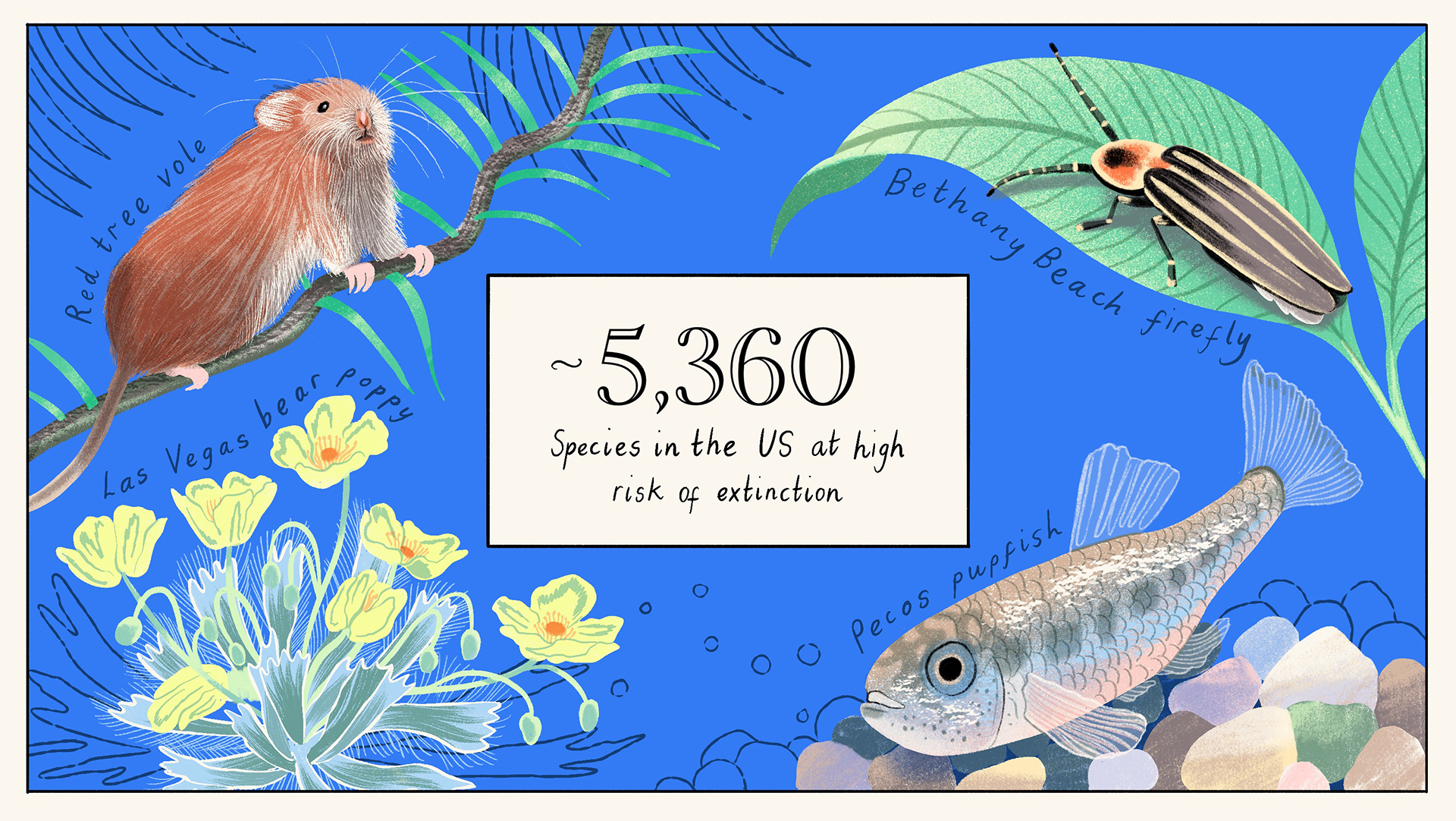
The Fish and Wildlife Service is aware of these delays. Gary Frazer, the agency’s assistant director for ecological services, which administers the act, blames them on funding and staff shortages. The process to formally declare a species endangered, which requires an extensive review, is expensive.
This is something that everyone seems to agree on: The FWS needs a lot more money from Congress to do its job. “Currently, the Service only receives around 50% of the funding required to properly implement the Act,” as more than 120 environmental groups wrote in a letter to Congress in March 2023, urging the government to ramp up spending by hundreds of millions of dollars. (That may sound like a lot, but it’s a tiny, nearly imperceivable fraction of what the US spends on, say, national defense, or fails to recoup in fossil fuel subsidies.)
“[The ESA] isn’t broken, it’s starving,” said Jamie Rappaport Clark, CEO and president of Defenders of Wildlife, a conservation group. (She’s stepping down from her role at Defenders next year.) “It can do its job if it’s supported,” said Clark, who formerly led the FWS. “But it’s not.”
Here’s what’s strange: Even though the FWS acknowledges there is a resource shortage, the agency doesn’t ask Congress for more money outside of relatively modest budget increases, according to Brett Hartl, government affairs director at the Center for Biological Diversity. What’s more, the FWS actually asks Congress to restrict the amount it can spend to list species as threatened or endangered. According to Frazer, that’s because the agency receives an enormous number of petitions. If it were to address all of them, he said, it would have to pull resources away from other important activities under the act.
(When asked why the FWS wouldn’t just request more money overall for the ESA, a spokesperson for the agency said that “federal funding decisions are complex” and pointed me to the agency’s recent budget justification. Hartl suspects the FWS doesn’t ask for more funding because Frazer is highly risk averse and doesn’t want to come under scrutiny for putting forward a more substantial budget request. There are also pro-industry ESA critics who say the law is already too restrictive, even in its underfunded state.)
Limited funding has forced officials and environmental advocates to prioritize efforts to save species in the most critical conditions — the ones that are about to blink out. And that leads to another criticism of the ESA: The law is reactive, helping species only when they’re on the edge of extinction. It fails to address more fundamental problems that are driving wildlife declines in the first place.
In search of a more proactive approach, some policymakers have been trying to pass another environmental law, known as Recovering America’s Wildlife Act (RAWA). The act, as it was envisioned a few years ago, would funnel roughly $1.4 billion to states and Indigenous tribes to restore ailing animals, even before they’re listed as endangered. But it has run into similar problems as the ESA — namely, policymakers can’t figure out how to pay for it. Now the RAWA, at least as it was originally drafted, seems all but dead.
It’s not that the US government can’t afford to fund conservation, said Ken Hayes, a conservation biologist at Hawaii’s Bishop Museum, who has studied endangered species for more than two decades. The problem, he said, is that we, as a society, don’t value biodiversity nearly as much as we should. “We don’t have a money problem,” he said. “We have a prioritization problem.”


